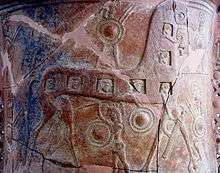Mykonos vase

The Mykonos vase, a pithos, is the earliest dated object (Archaic period, c.675 BC.) which depicts the Trojan Horse during the Trojan War. It was found in 1961 (with human bones inside) on Mykonos, the Greek island for which it is named, by a local inhabitant.[1]
Breakdown of the Pithos
The neck of the pithos portrays the moment when the Trojan horse is surrounded by (Greek) warriors, with additional warriors seen in the 'portholes'. Beneath, there are three lines of metopes each containing figures poised in battle. The lower part of the vase is blank.
The warriors which surround the horse are represented in a formulaic manner. Their heads and legs appear behind rounded bossed shields and they carry spears. Those presented on the upper metope are portrayed in a similar fashion. However, the warriors on the main body do not carry shields and can be seen assailing women (and children) who face them. The women have thick manes of hair and expressive hand gestures. The use of friezes offers some links with 8th century bc. Geometric painted pottery. This is suggestive of having influences from the east.
There are two factors that ensure that the Mykonos vase does in fact depict the sack of Troy. Firstly, the inclusion of the wooden horse and secondly the subordination of individual scenes of slaughter that accompany the scene of the horse on the neck. This scene dominates the "pithos" and shows warriors in the 'portholes' of the Trojan horse. The shoulder and body go on to present warriors in action. The metopes give the view into the horse, as view what the horse holds in store, alternatively one may view them as what comes out of the horse.
In this piece, the artist has chosen to present the battle in the town as a battle against women and children. There are no Trojan warriors present to defend his womenfolk. The artists decision to separate the scenes of slaughter and link them with cunning trick of the horse, serves as a way of focussing the attention of the viewer on the cold-bloodedness of the killing and the way the sacking of the town differs from the fighting on the frontline.
There are three metopes that stand out in the "pithos". At the far-right of the middle row there is a lone warrior drawing his sword and advancing. At the far-left panel is a lone women, clasping her hands to her breast. Finally, arguably the most important metope, is located directly below the horse in the centre of the panels is a single warrior that has been stabbed in the neck, crumpled over his shield whilst his right hand grasps for his scabbard. Amongst the violence, we are presented with three single figures. Two of which are not bound up by the action but able to contemplate, and one lone dead warrior, the single case where fate has pointed in a different direction. The decision to depict single figures emphasises the potential victims and of what action is still to occur. The decision to include one dead warrior is quite interesting. It is unknown whether this warrior is Greek or Trojan, but perhaps the artist's placing of the figure in such prominent view is their way of raising the point that it does not matter which side he was on, his fate was still the same.
By combining the scene of the Trojan horse and framed scenes of slaughter, on a burial pot, the artist frames the viewer. This pot alludes to stories and episodes within stories, but precludes any easy stringing of episodes together. More importantly, this pot manipulates the issue of "viewpoint". It encourages the viewer to see through the 'portholes' of the horse as if they were one of the Greek assailants whilst presenting the sack of Troy as slaughter of the defenceless that evokes sympathy for victims of war. [2]
References
- ↑ Paipetis, S. A (2010). The Unknown Technology in Homer. Springer Science & Business Media. p. 171. ISBN 978-90-481-2514-2.
- ↑ .Osborne, Robin (1998). Archaic and Classical Greek Art. Oxford University Press. pp. 54–58.
Bibliography
- Michael John Anderson, The Fall of Troy in Early Greek Poetry and Art, 1997.
- Miriam Ervin Caskey, "Notes on Relief Pithoi of the Tenian-Boiotian Group", AJA, 80, 1976, pp. 19–41.
- M. Ervin, "A Relief Pithos from Mykonos", Deltion, 18, 1963, 37-75.
- J.M. Hurwit, The Art and Culture of Early Greece, 1100-480 B.C, 1985
- M. Wood, In Search of the Trojan War, 1985.
- http://www.uwm.edu/Course/mythology/1200/twar2.htm